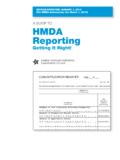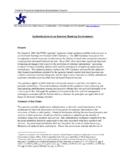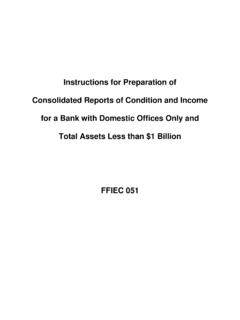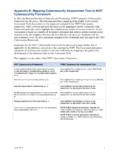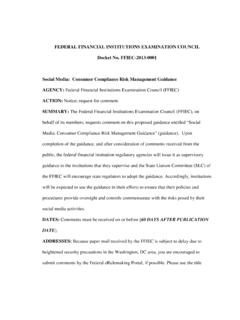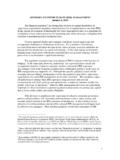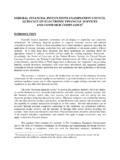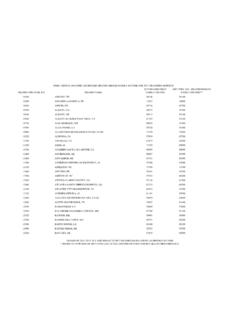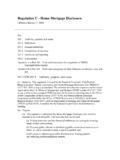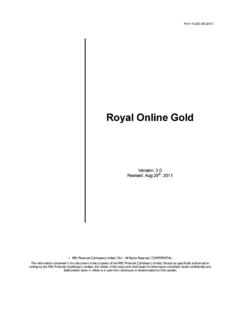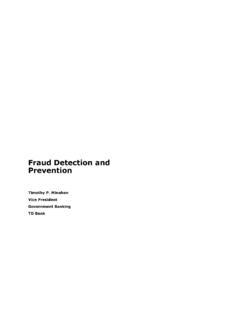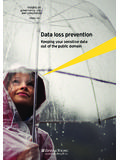Transcription of Supplement to Authentication in an Internet …
1 BBooaarrdd ooff GGoovveerrnnoorrss ooff tthhee FFeeddeerraall RReesseerrvvee SSyysstteemm,, FFeeddeerraall DDeeppoossiitt IInnssuurraannccee CCoorrppoorraattiioonn,, NNaattiioonnaall CCrreeddiitt UUnniioonn AAddmmiinniissttrraattiioonn,, OOffffiiccee ooff tthhee CCoommppttrroolllleerr ooff tthhee CCuurrrreennccyy,, OOffffiiccee ooff TThhrriifftt SSuuppeerrvviissiioonn,, SSttaattee LLiiaaiissoonn CCoommmmiitttteeee Federal Financial Institutions Examination Council 3501 Fairfax Drive Room B7081a Arlington, VA 22226-3550 (703) 516-5588 FAX (703) 562-6446 Supplement to Authentication in an Internet banking Environment Purpose On October 12, 2005, the FFIEC agencies1 (Agencies) issued guidance entitled Authentication in an Internet banking Environment (2005 Guidance or Guidance).
2 2 The 2005 Guidance provided a risk management framework for financial institutions offering Internet -based products and services to their customers. It stated that institutions should use effective methods to authenticate the identity of customers and that the techniques employed should be commensurate with the risks associated with the products and services offered and the protection of sensitive customer information. The Guidance provided minimum supervisory expectations for effective Authentication controls applicable to high-risk online transactions involving access to customer information or the movement of funds to other parties.
3 The 2005 Guidance also provided that institutions should perform periodic risk assessments and adjust their control mechanisms as appropriate in response to changing internal and external threats. The purpose of this Supplement to the 2005 Guidance ( Supplement ) is to reinforce the Guidance s risk management framework and update the Agencies expectations regarding customer Authentication , layered security, or other controls in the increasingly hostile online environment. The Supplement reiterates and reinforces the expectations described in the 2005 Guidance that financial institutions should perform periodic risk assessments considering new and evolving threats to online accounts and adjust their customer Authentication , layered security, and other controls as appropriate in response to identified risks.
4 It establishes minimum control expectations for certain online banking activities and identifies controls that are less effective in the current environment. It also identifies certain specific minimum elements that should be part of an institution s customer awareness and education program. 1 Board of Governors of the Federal Reserve System, Federal Deposit Insurance Corporation, National Credit Union Administration, Office of the Comptroller of the Currency, and Office of Thrift Supervision. 2 FRS SR Letter 05-19, October 13, 2005; FDIC Financial Institution Letter 103-2005, October 12, 2005; NCUA Letter to Credit Unions 05-CU-18, November 2005; OCC Bulletin 2005-35, October 2005; OTS CEO Memorandum 228, October 12, 2005.
5 22 Background Since 2005, there have been significant changes in the threat landscape. Fraudsters have continued to develop and deploy more sophisticated, effective, and malicious methods to compromise Authentication mechanisms and gain unauthorized access to customers online accounts. Rapidly growing organized criminal groups have become more specialized in financial fraud and have been successful in compromising an increasing array of controls. Various complicated types of attack tools have been developed and automated into downloadable kits, increasing availability and permitting their use by less experienced fraudsters.
6 Rootkit-based malware surreptitiously installed on a personal computer (PC) can monitor a customer s activities and facilitate the theft and misuse of their login credentials. Such malware can compromise some of the most robust online Authentication techniques, including some forms of multi-factor Authentication . Cyber crime complaints have risen substantially each year since 2005, particularly with respect to commercial accounts. Fraudsters are responsible for losses of hundreds of millions of dollars resulting from online account takeovers and unauthorized funds The Agencies are concerned that customer Authentication methods and controls implemented in conformance with the Guidance several years ago have become less effective.
7 Hence, the institution and its customers may face significant risk where periodic risk assessments and appropriate control enhancements have not routinely occurred. General Supervisory Expectations The concept of customer Authentication , as described in the 2005 Guidance, is broad. It includes more than the initial Authentication of the customer when he/she connects to the financial institution at login. Since virtually every Authentication technique can be compromised, financial institutions should not rely solely on any single control for authorizing high risk transactions, but rather institute a system of layered security, as described herein.
8 3 See IC3 Annual Internet Crime Reports 2005-2009. 33 Specific Supervisory Expectations Risk Assessments The Agencies reiterate and stress the expectation described in the 2005 Guidance that financial institutions should perform periodic risk assessments and adjust their customer Authentication controls as appropriate in response to new threats to customers online accounts. Financial institutions should review and update their existing risk assessments as new information becomes available, prior to implementing new electronic financial services, or at least every twelve Updated risk assessments should consider, but not be limited to, the following factors: changes in the internal and external threat environment, including those discussed in the Appendix to this Supplement ; changes in the customer base adopting electronic banking ; changes in the customer functionality offered through electronic banking .
9 And actual incidents of security breaches, identity theft, or fraud experienced by the institution or industry. Customer Authentication for High-Risk Transactions The 2005 Guidance s definition of high-risk transactions remains unchanged, , electronic transactions involving access to customer information or the movement of funds to other parties. However, since 2005, more customers (both consumers and businesses) are conducting online transactions. The Agencies believe that it is prudent to recognize and address the fact that not every online transaction poses the same level of risk. Therefore, financial institutions should implement more robust controls as the risk level of the transaction increases.
10 Retail/Consumer banking Online consumer transactions generally involve accessing account information, bill payment, intrabank funds transfers, and occasional interbank funds transfers or wire transfers. Since the frequency and dollar amounts of these transactions are generally lower than commercial transactions, they pose a comparatively lower level of risk. Financial institutions should implement layered security, as described herein, consistent with the risk for covered consumer transactions. 4 See FFIEC IT Examination Handbook, Information Security Booklet, July 2006, Key Risk Assessment Practices section.
